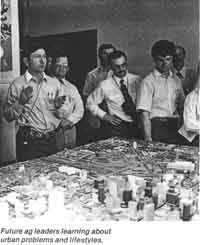Winter 1985 // Volume 23 // Number 4 // Ideas at Work // 4IAW1
The Urban Learning Experience
Abstract
East is East, and West is West and never the twain shall meet-or so it was before the Oklahoma Agricultural Leadership Program (OALP) came to Baltimore in March, 1985.
Not only did east and west meet, but city and country met. At a time when many Americans don't understand the plight of farms or cities, 30 farmers and agribusiness professionals came to Baltimore to bridge that gap.
For many in the group, the Urban Learning Experience provided them with firsthand knowledge of a Northeast metropolitan area. According to OALP Director William Taggert, this was "the first time that many got the chance to explore the problems of urban life."
Baltimore's innovative revitalization projects and distinction as an old well-established city attracted OALP, as well as its ethnically and racially diverse neighborhoods. "As future leaders, OALP members need exposure to different kinds of people," Taggert said. Next year, the organization will travel to Brazil.
OALP is offered by Oklahoma State University. Its members are carefully screened by a panel of Oklahoma educators before being accepted into the two-year intensive study/travel program. They're chosen for their leadership potential and trained to assume roles as future agriculture leaders at state, national, and international levels. Similar programs exist in 25 other states.
 "As future agriculture leaders, they must understand urban problems and lifestyles. The Baltimore trip gave them a chance to understand the food supply from the consumers' end, and learn the likes and dislikes of the consumers."
"As future agriculture leaders, they must understand urban problems and lifestyles. The Baltimore trip gave them a chance to understand the food supply from the consumers' end, and learn the likes and dislikes of the consumers."
They were very curious about everyday city survival-affordable housing in nice neighborhoods, the cost of food, public housing, unemployment, and crime.
During the three-day stay, OALP members explored various aspects of Baltimore urban living.
In small groups, the Oklahomans met with City Council members to learn about city government, interacted with the students at Carver Vocational Technical High School to learn their concerns, visited Extension urban gardening sites, and observed nutrition aides instructing clients. Others met with bankers and church leaders.
If anything, these men and women from the wide open plains experienced culture shock. At Madison Park, where several residents opened their homes for inspection, the Oklahomans, misled by the rowhouses' narrow facade, were surprised to find the houses much roomier than anticipated. They explained that because of tornadoes, three-story homes could be hazardous in Oklahoma.
At the debriefing lunch, many of the Oklahomans explained the misconceptions they had of city life before coming to Baltimore: "lack of community," "masses of people," "streets filled with crooks." Some of these stereotypes were dispelled; one said he found the people to be "a lot friendlier" than he expected.
Stephanie Brown, Baltimore City Extension director, said she feels a need exists for future Urban Learning Experience programs to educate other visiting agricultural leadership groups. "This experience can provide direct exposure to life in a major urban area. It can also provide an opportunity for local leaders to share and obtain information about topics of mutual interest for better understanding."
